|
The Revolutionary ContourHD 1080p
Camcorder and H20V Housing: A great choice for shooting video underwater
(by Carol Cotton; video and stills by Carol Cotton and Conrad Blickenstorfer)
A few months ago, while flying across the country, I ran across a camcorder in SkyMall magazine that really caught my eye. It was called the ContourHD 1080p and, apparently, had been created to easily record high definition video in extreme sports such as racing, mountain biking and skiing. Since snow skiing involves frozen water, I immediately wondered if this little camera would somehow be used for scuba diving. Back in the office, I dashed off an email to the company and asked if we could check it out. They were happy to oblige. Better yet, they also have a small and handy underwater housing for the little marvel.
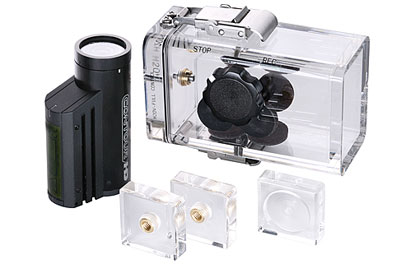
Turns out that Keith of Emerald Diving has been shooting a lot of video in the Pacific Northwest using this system for quite some time. Their website (www.emeralddiving.com) has video showing some of the wonderful creatures and scenery he has encountered there.
So Keith sent us a camera and housing to try during a dive trip to the Channel Islands. I inventoried the contents of the box, read the included instructions, and familiarized myself with the camera, the housing, and how to operate each. As with all of our underwater camera reviews, we tested the ContourHD in the pool first to make sure everything was functioning properly, to check for leaks, and to test the focal range and image size. I was amazed at the clarity and quality of the video! Originally, I'd been a bit concerned about shooting video with a camera that didn't have any type of viewing screen, but with some practice I eventually got pretty good at it.
The ContourHD 1080p video camera
Unbelievably Small
According to the Contorur website, the Contour HD is "the smallest and lightest HD Wearable Camcorder in the world." After holding one in my hand, I'm am inclined to believe their claim. It's tiny, at 4.3 ounces weighs less than an iPhone, and measuring 3.75" long by 2.25" tall by slightly over 1.25" wide, is actually smaller than a lot of the point-and-shoot digital cameras on the market these days.
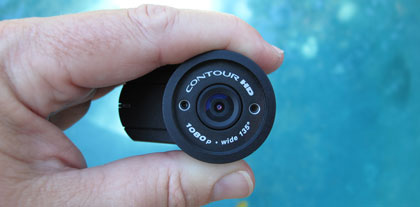
Part of what allows the ContourHD 1080p video camera to be so small is the lack of a LCD screen and the almost complete lack of external controls, buttons and knobs. There's a power button on the back of the camera and an off/record switch on the top. Despite the small size of the camera itself, the off/record switch is large enough (3/4" x 1-7/8") to be easily operated even with a large, bulky pair of gloves on.
The camera records on an internal microSD memory card and can capture hours of your activities with hands-free operation. It comes with a 2GB card, but can accept cards with up to 16GB storage capacity. As is, a 2GB card can record about an hour of 720p video and 30 minutes of full 1080p video, so having a high-capacity card will always come in handy.
There are several record modes, depending on card capacity and intened use of the video:
- Full HD - 1080p (1920X1080)
- Tall HD - 960p (1280X960)
- Action HD - 720p (1280X720)
- Contour HD - 720p (1280X720)
- Fast HD - WVGA (848X480)
Recording frame rate is usually 30 fps, but the camera can also record at a blistering 60 fps in 720p and WVGA mode.
Now why doesn't the ContourHD have a LCD? That's because it was initially designed as a fixed-mount camera for helmets and such where a LCD was not needed and would only have increased size and cost. However, the designers knew that a wide viewing angle was pretty much mandatory in this type of camera, and so the ContourHD records with a 135-degree wide angle lens in 720p and 960p mode, and still at 115-degrees in 1080p mode. That's certainly a bonus when shooting underwater video. The wide format gives you a better sense of how it really looks being underwater swimming with hundreds of varieties of fish and other marine life. The camera includes a 5 megapixel sensor and uses .mov file format.
One neat feature we've yet to see anywhere else is a rotating lens with dual laser alignment. The lens rotates 180 degrees, so it's much easier to line up your shot depending on what position you mount the camera. The test unit we had was designed to work best inside the housing with the lens at a 90 degree turn to the left so that the camera is on its side in the housing. The two laser beams are meant to let you properly frame your shot.
The camera body itself is water-resistant anodized aluminum, along with being shock, vibration, and impact resistant. Our main concern was how the camera and housing performed underwater, so we'll take their word for it on the other features.
The camera uses a removable, rechargeable 1050 mAh lithium-ion battery that lasts for up to three hours of use. For charging, you can leave the battery in the camera and use the included USB cable to plug into a computer. A full charge takes roughly four hours. Contour also offers a conventional wall charger and a car charger.
Lacking a status LCD, finding out how much battery life you have left before starting to use, or while using, the camcorder requires a bit of a secret handshake: When booting up your camcorder the status lights on the back will flash. During the third and final flash, the top light will either flash red or green. Green means you have a full battery while red means it's low. You can even check it while it's in standby mode by pushing the power button. The top light will flash the battery status of red or green.
Easy Edit Software
While the ContourHD doesn't have any conventional onboard hardware controls, you can configure it via software. The company's Easy Edit software, available for both Windows and the Mac OS, can be used for configuring the ContourHD camera, as well as manage and share video. Not only can you upload your videos with this software, but you can also change settings on the camera, as well.
There are two panels - one for video (see below) and the other is for audio and lighting. On the video panel you set the bit rate from medium to high to maximum. You can also program the camera for two different resolutions and change them on the fly by switching the hi/low switch under the back cover. On the audio and lighting panel you can set the microphone gain. You can also make lighting adjustments such as contrast, exposure, sharpness, and metering by way of editable presets. When you're done making the adjustments you can download them to the camera. Very clever!
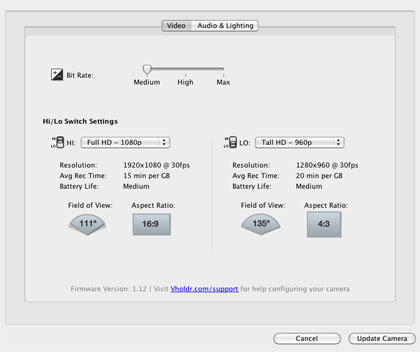
The screen below shows the video editing/tagging/sharing part of Easy Edit. It won't replace iMovie HD, but is very intuitive and I ended up using it a lot while we had the ContourHD in our lab.
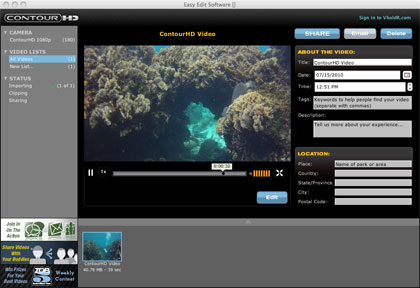
Installation only takes a couple of minutes and is self-explanatory. There's a link on the Contour website titled Video Community where people from all over the world register and upload their videos. I tried it by adding one of my favorite video clips I titled "Blue Tangs on Parade."
The H2OV Housing
Amazingly Simple and Easy to Operate
The H20V housing for the ContourHD is small, lightweight, and easy to carry and operate. It's designed for recreational scuba diving as well as technical diving, with a maximum depth rating of 300 feet. The housing is made right here in the USA by a company called GMS Concepts, and it's obvious that a lot of thought and testing went into the design. There are only two external controls. The power on/off button is on the back of the housing, and the off/record knob is on the top of the housing. The off/record knob operates via a magnetic connection through the acrylic, which reduces the points of failure on the housing.
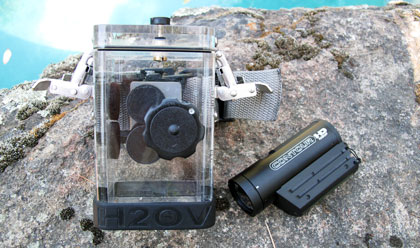
The boxy H2OV housing weighs about a pound and is roughly the size of a small dSLR body. It is made of high-grade cell-cast acrylic with walls that are half an inch thick. There's a scratch-resistant coating on the lens surface (but it should still be transported and stored in a protective case). The lid is made for a perfect fit, sealing with a heavy-duty high quality O-Ring and two stainless steel spring-loaded latches with safety catches to prevent the housing from opening accidentally.
The 5 x 2-1/8 x 3 inch H20V housing is so compact that you barely know it's on your hand when you're underwater. There is a multi-use universal mount so that the camera can be worn on light handle mounts, scooters, a dive helmet, on top of a camera housing, on stability mount, and even on a dive mask when used with a VholdR goggle mount with some minor alterations. When worn on your hand, the system is held in place by a 1.5-inch-wide nylon strap with a quick release. It fits comfortably on your hand with a wide pad to help cushion between the top of your hand and the video unit.
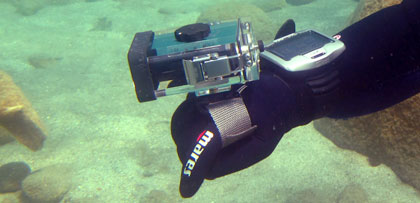
Our Underwater Experiences with the Contour HD System
Channel Islands, California
Our first outing using the Contour HD/H2OV system was to the northern Channel Islands off the coast of Santa Barbara, California. It was pretty challenging diving because of poor visibility, cold water, swift surge and strong currents. However, using the Contour HD while wearing thick dive gloves turned out to be no problem at all. The stability strap and the controls were easy to use. I used the unit on two consecutive dives, so I didn't have time during our surface interval to see what the video looked like. The unit fit well on my gloved hand and was easy to aim. I extended my arm and tried to aim the camera at what I was looking at. To be honest, I felt a little like a highway patrolman aiming a radar gun!
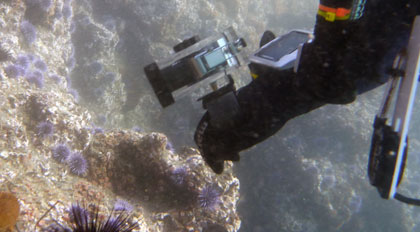
After our dives, I soaked the housing in the camera tank for an hour or so, then dried it off before removing the camera. We had brought along a handy little Acer Aspire One netbook to review our pictures and video. Sadly, we forgot that most netbooks are notoriously poor at HD video playback, and so watching the CountourHD video was all but a lost cause.
Once we got back to the lab, we viewed the footage on my iMac and I realized I had made a terrible error! Even though I had practiced with the unit in the pool before the trip, the old "lefty loosy, righty tighty" remained in my head, meaning the camera was off when I thought it was on and vise versa!
Lake Tahoe, California
A couple of days later we packed our dive gear in the vehicle and headed for a day of diving at Lake Tahoe, altitude 6,230 feet. The water was only slightly warmer than the Channel Islands, but it was much clearer and there was no current. Unfortunately, Lake Tahoe lacks the plants and creatures that reside in the Channel Islands, so I had to settle for shooting video of hundreds of crawdads and rocks. However, the end results was drastically different! We used the system in depths ranging from 10 feet up to 75 feet. There's not as much color in lakes as there is in the oceans and the water is much greener, but the ContourHD video looked great!
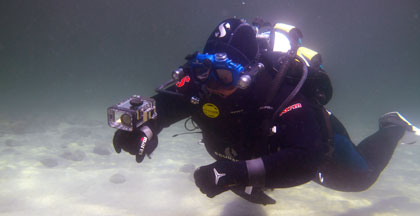
Roatan, Honduras
Even though Keith sent us the camera and housing on loan for a month, he was gracious enough to allow us to keep it a few weeks longer. We booked a product review trip to our favorite resort (CoCo View Resort) on the Bay Island of Roatan off the coast of Honduras during which we did 28 dives and accumulated almost 35 hours of bottom time. We used the Contour HD on most dives and scored some amazing footage.
We shot video of huge schools of blue tangs foraging on coral on shallow reefs, lionfish displaying their venomous quills in order to protect themselves, eels out free swimming during the day, tiny secretary blennies hiding in star corals, and even some rare footage of a pair of sailfin blennies courting.
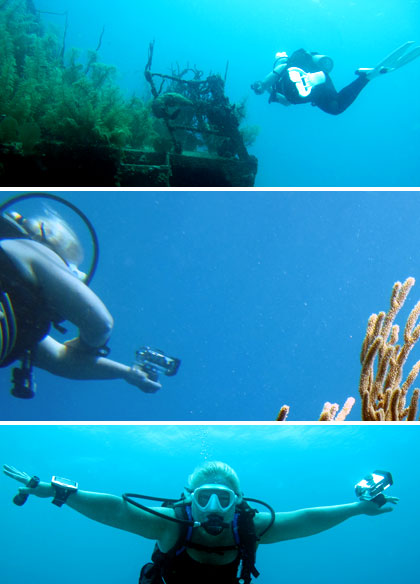
We were also able to shoot in bright sunshine on some of the shallow reefs right in front of the resort. Underwater video (and photography) is all about light and colors quickly disappear as you go deeper. So without a strobe, which we didn't have for the ContourHD, shooting in shallow water makes for the most colorful, vibrant video.
One of the things I really like about this system is its size and maneuverability. With it fitting comfortably on top of my hand, it was much easier to get footage in small, confined spaces a much larger system could never reach. Its small size made getting excellent video of fish much easier, and I believe that's because the fish were less intimidated by the size of the equipment.
The ContourHD 1080p with H2OV Housing...
We like:
- The H20V housing and ContourHD 1080p camcorder system is small, lightweight and simple to use.
- The controls are few and easy to use even when wearing thick gloves.
- The results are high quality 1080p video with excellent color, clarity and overall quality.
- The memory capacity and battery life are very good, with a maximum memory capacity of 16GB and a battery life of roughly three hours.
- The system can be used for recreational or technical diving applications and is conservatively rated to 300 feet.
- Both the camcorder and the housing are made of sturdy, high quality materials and are built to last.
- Love the easy to use software for making adjustments to the camcorder and uploading videos to their website for sharing.
Not so much:
- You need a good light source. Without lights, as typical with scuba diving, color begins to disappear at 15 feet.
- I'm not totally crazy about the indicator lights. They're not easy to see, and fade dramatically in shallow, well-lit waters.
- The Off/Record markings should be more prominent.
|










